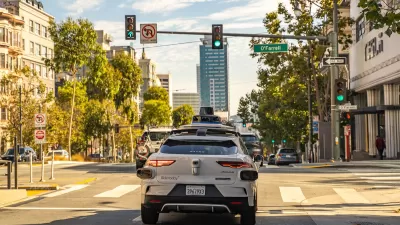The automated decision-making processes of self-driving cars are ill equipped to protect that safety of people of color in public.

"If you’re a person with dark skin, you may be more likely than your white friends to get hit by a self-driving car," reports Sigal Samuel.
That's the finding of a new study [pdf] by researchers at the Georgia Institute of Technology report that analyzed autonomous vehicles footage from New York City, San Francisco, Berkeley, and San Jose. Samuel explains the study in more detail:
The authors of the study started out with a simple question: How accurately do state-of-the-art object-detection models, like those used by self-driving cars, detect people from different demographic groups? To find out, they looked at a large dataset of images that contain pedestrians. They divided up the people using the Fitzpatrick scale, a system for classifying human skin tones from light to dark.
The researchers then analyzed how often the models correctly detected the presence of people in the light-skinned group versus how often they got it right with people in the dark-skinned group.
The results of the study are concerning, to say the least.
Detection was five percentage points less accurate, on average, for the dark-skinned group. That disparity persisted even when researchers controlled for variables like the time of day in images or the occasionally obstructed view of pedestrians.
Samuel ties the problem to the record of algorithmic bias—human bias influencing the results of automated decision-making systems. The human failure behind the machine's failure also implies potential solutions to the problem.
FULL STORY: A new study finds a potential risk with self-driving cars: failure to detect dark-skinned pedestrians

Planetizen Federal Action Tracker
A weekly monitor of how Trump’s orders and actions are impacting planners and planning in America.

San Francisco's School District Spent $105M To Build Affordable Housing for Teachers — And That's Just the Beginning
SFUSD joins a growing list of school districts using their land holdings to address housing affordability challenges faced by their own employees.

The Tiny, Adorable $7,000 Car Turning Japan Onto EVs
The single seat Mibot charges from a regular plug as quickly as an iPad, and is about half the price of an average EV.

As Trump Phases Out FEMA, Is It Time to Flee the Floodplains?
With less federal funding available for disaster relief efforts, the need to relocate at-risk communities is more urgent than ever.

With Protected Lanes, 460% More People Commute by Bike
For those needing more ammo, more data proving what we already knew is here.

In More Metros Than You’d Think, Suburbs are Now More Expensive Than the City
If you're moving to the burbs to save on square footage, data shows you should think again.
Urban Design for Planners 1: Software Tools
This six-course series explores essential urban design concepts using open source software and equips planners with the tools they need to participate fully in the urban design process.
Planning for Universal Design
Learn the tools for implementing Universal Design in planning regulations.
Smith Gee Studio
City of Charlotte
City of Camden Redevelopment Agency
City of Astoria
Transportation Research & Education Center (TREC) at Portland State University
US High Speed Rail Association
City of Camden Redevelopment Agency
Municipality of Princeton (NJ)





























